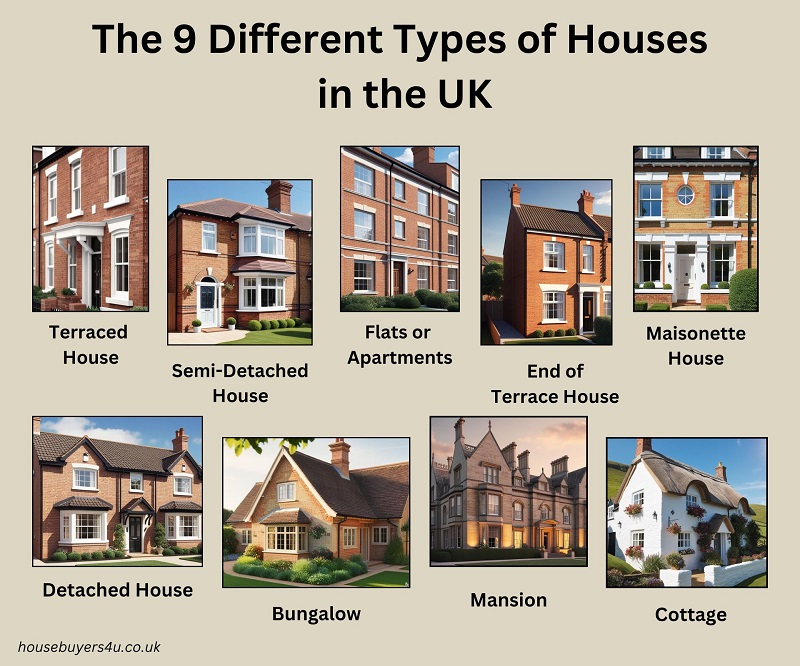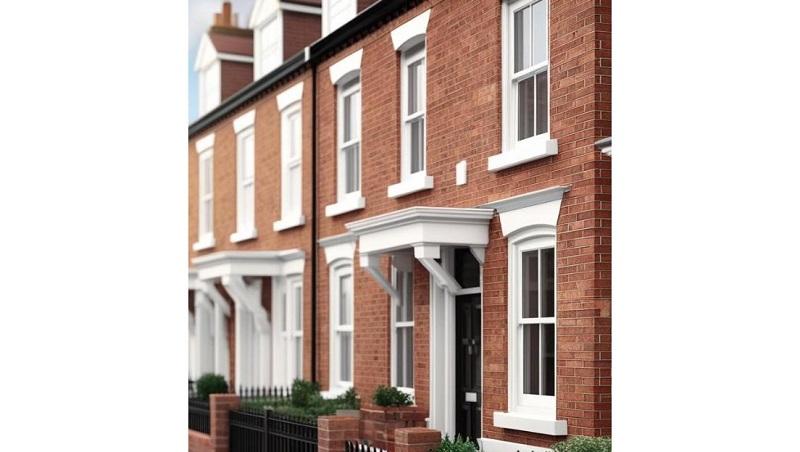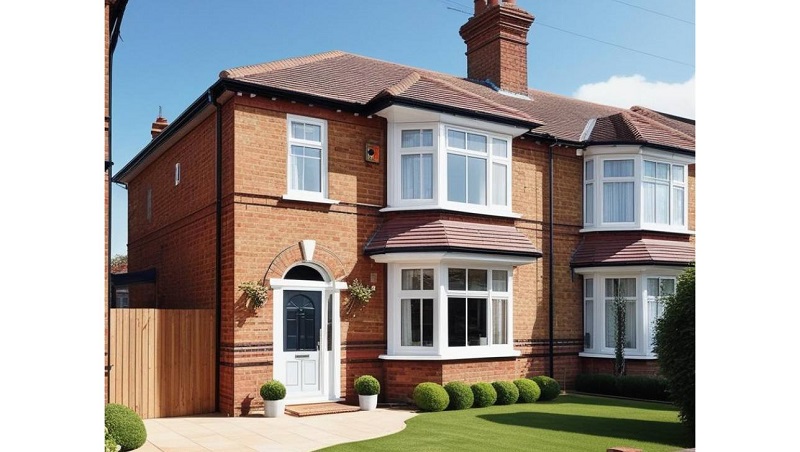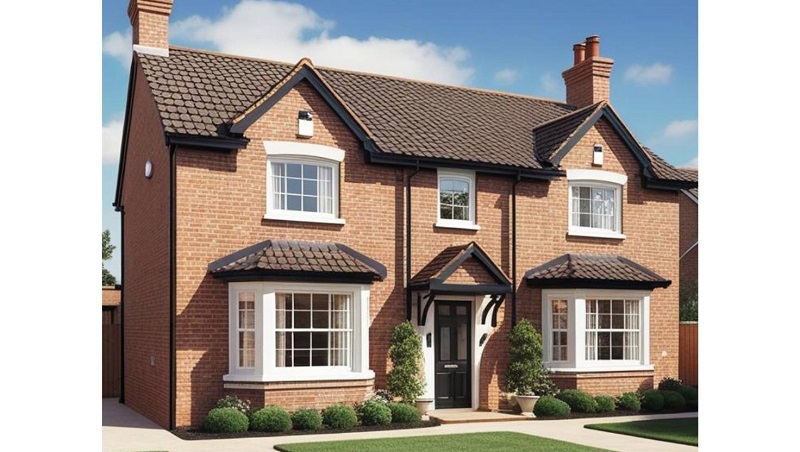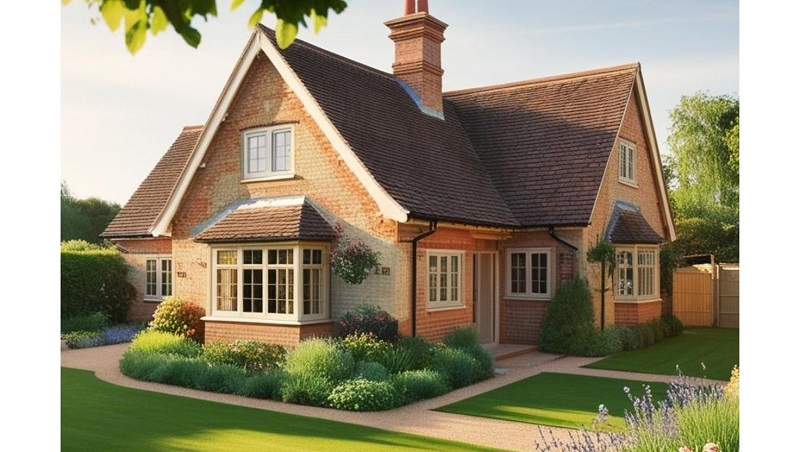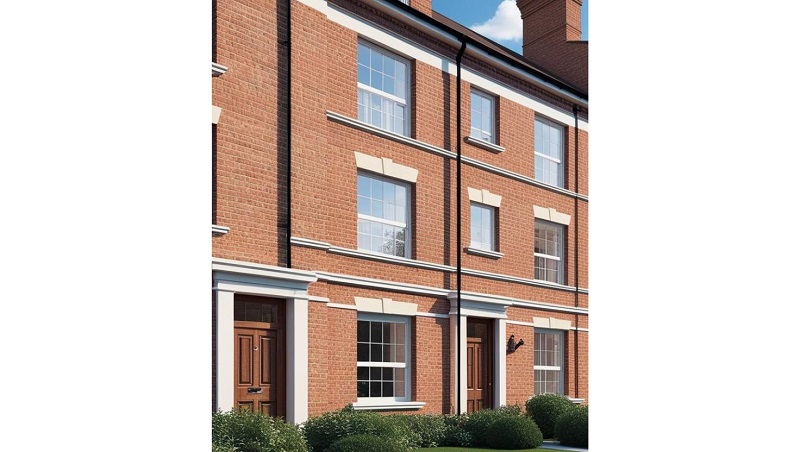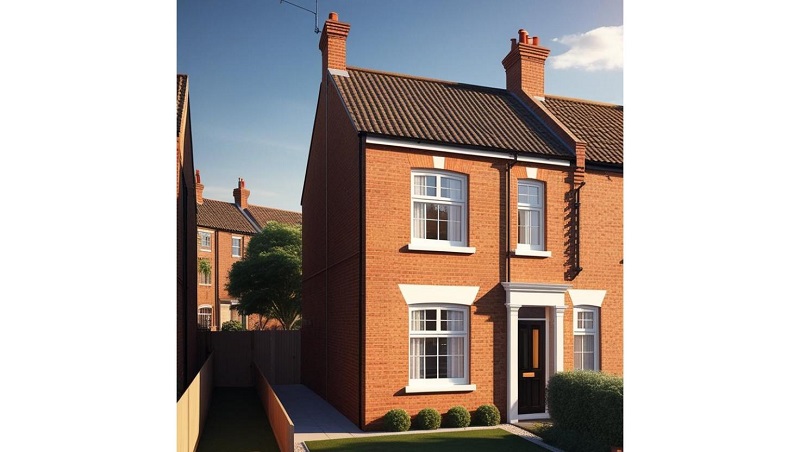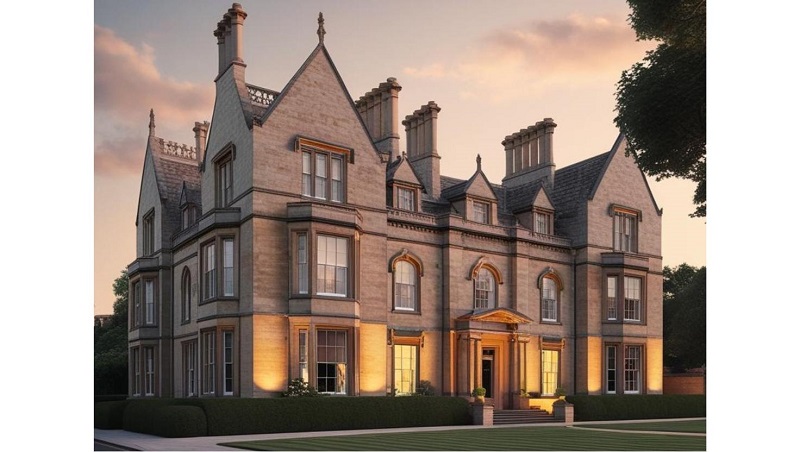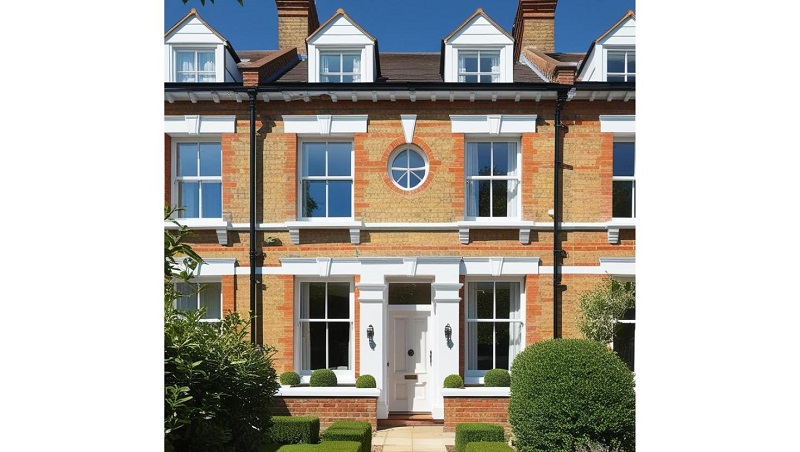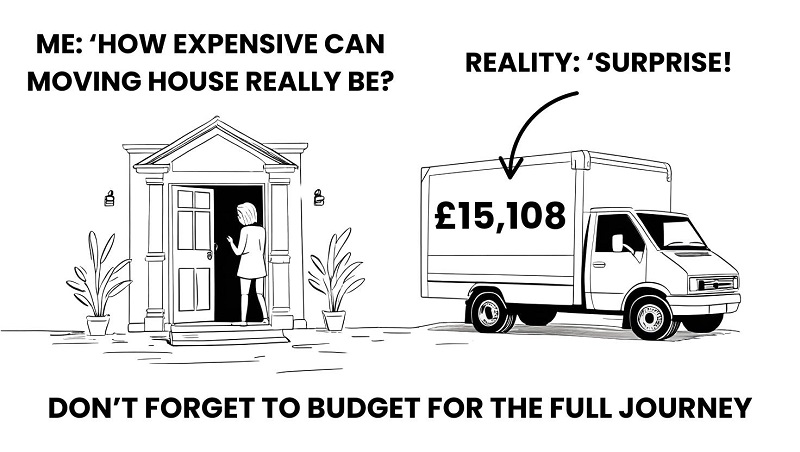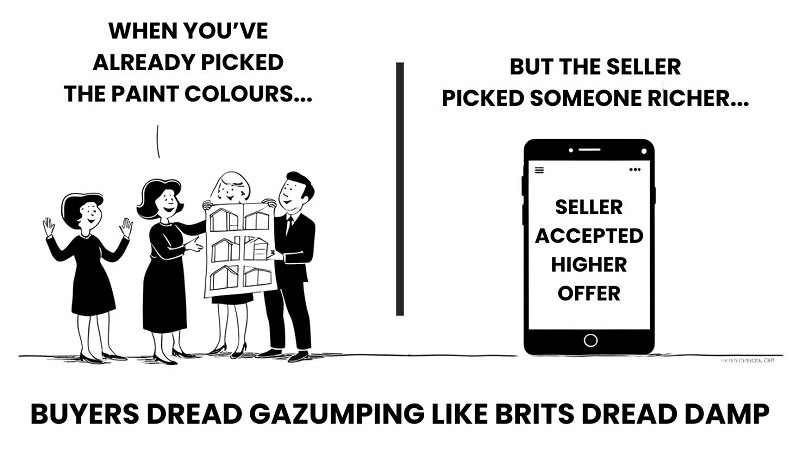9 Types of Houses UK (Pro’s & Cons of Each)
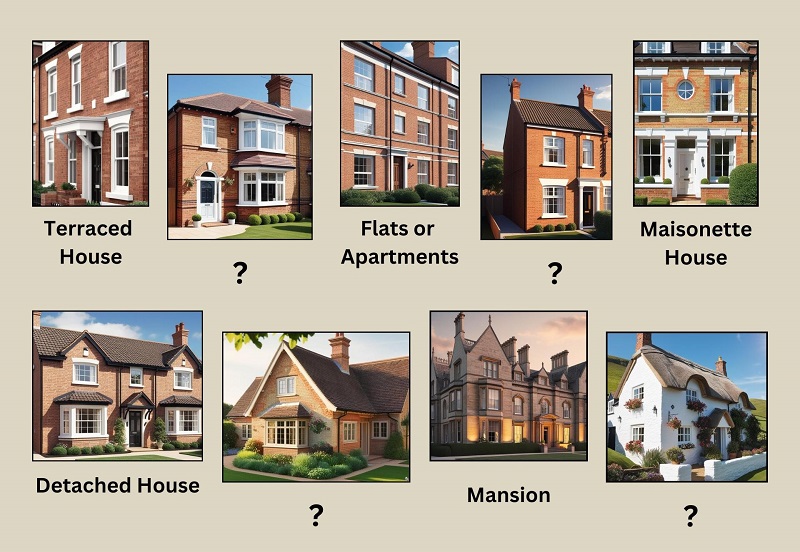
Updated: April 2025
The UK has a wide range of house types, each offering different benefits depending on your budget, location, and lifestyle. Whether you’re looking for affordability, space, privacy, or convenience, understanding the pros and cons of each type will help you make a better buying decision.
Key Takeaways:
- From £150,000 to £2M+: 9 house types that cover every budget and lifestyle need.
- Semi-detached homes are most common overall, but flats dominate city areas.
- The best home depends on your budget, location, and need for space or privacy.
1) What are the Different Types of Houses in the UK?
There are nine main types of houses across the UK, each with its own style, layout, and pros and cons. Whether you're after a modern flat, a cosy cottage, or a spacious detached house, it helps to know what each one offers — and how much you might pay.
| House Type | Avg Price (England, from latest ONS data) |
|---|---|
| Detached House | £500,000 |
| Semi-Detached House | £298,000 |
| Terraced House | £279,000 |
| End of Terrace House | £329,000 (est. 18% more than terraced) |
| Bungalow | £307,000 (varies by region) |
| Cottage | £314,500 (rural average) |
| Flat / Apartment | £273,000 |
| Maisonette House | £150,000–£500,000+ (location dependent) |
| Mansion | £2M+ |
This is what each house looks like:
1) Terraced Houses
A terraced house is part of a continuous row, sharing side walls with neighbouring homes. These are often cheaper than detached or semi-detached properties and remain popular in many UK cities.
They became widespread in the 19th century to house the working class and are still common in places like Manchester.
Average price (England): £279,000
Advantages of Purchasing a Terraced Home
Pro 1: Generally speaking, a terraced home is the cheapest type of housing you can purchase in the UK.
Pro 2: They require less maintenance overall because of their smaller square footage.
Pro 3: Potentially safer and more secure because you have two sets of neighbours close by.
Disadvantages of Purchasing a Terraced Home
Con 1: Terraced houses are smaller than their semi-detached counterparts, so they inevitably come with less space.
Con 2: They come with little to no garden space.
Con 3: You have two sets of neighbours, so you can expect to hear them from time to time, which means less privacy.
2) Semi-Detached Houses
A semi-detached house is joined to another on one side only. It offers more space and privacy than a terraced home but is cheaper than a detached house.
These became common in the late 18th century as a middle-ground suburban option.
Average price (England): £298,000
Advantages of Purchasing a Semi-Detached Home
Pro 1: You get an increased amount of privacy compared to terraced homes.
Pro 2: There is more garden space and square footage available than a terraced home.
Pro 3: Semi-detached homes are more affordable than detached homes.
Disadvantages of Purchasing a Semi-Detached Home
Con 1: If you plan to extend your home, you have to consider your neighbours.
Con 2: Noise transfer: Sharing a wall with a neighbouring property can still result in noise issues.
Con 3: Increased maintenance compared to terraced home.
3) Detached Houses
A detached house stands alone, with no shared walls. It’s typically more expensive than terraced or semi-detached homes and offers the most privacy, space, and land.
Common in rural and suburban areas, detached homes suit families needing room — but they come with higher maintenance demands.
Average price (England): £500,000
Advantages of Purchasing a Detached Home
Pro 1: Detached homes come with more land, which you can pretty much use as you please.
Pro 2: You get total privacy as your house is located on its own plot.
Pro 3: Extending or renovating your home with new specs is more straightforward as you require less approval.
Disadvantages of Purchasing a Detached Home
Con 1: There is a lot more maintenance and upkeep involved compared to semi-detached and terraced property types.
Con 2: Detached homes are generally the most expensive type of home from the seven on our list.
Con 3: Some people may experience a feeling of isolation as there are no neighbours close by.
Advice from our property expert Paul:
“Detached homes remain one of the most desirable types of property in the UK because they offer the ultimate combination of space and privacy. However, many buyers underestimate the long-term costs involved, from higher energy bills to exterior maintenance.
I always advise buyers to budget carefully—not just for the purchase price, but also for the ongoing costs that come with full responsibility for the building and land. It's the dream for many, but it’s important to plan practically too.”
4) Bungalows
A bungalow is a single-storey home, sometimes with rooms in the roof and dormer windows. They offer easy access and are popular with older buyers.
Due to limited supply and high demand, especially in certain regions, bungalows can sell for up to twice the price of a typical home in the UK.
Advantages of Purchasing a Bungalow
Pro 1: Bungalows, for the most part, are cheaper than storied homes.
Pro 2: They are easier to clean and maintain as there is only one floor and no stairs.
Pro 3: They hold their value quite well, as fewer bungalows are being built every year.
Disadvantages of Purchasing a Bungalow
Con 1: Being only a one-storey house, breaking in through bungalow windows and getting access to key rooms like the bedroom is easier.
Con 2: Bungalows have the highest cost per square foot as they are built across more land.
Con 3: Larger living areas in bungalows usually mean smaller bedroom sizes.
5) Cottages
A cottage is a small, traditional home usually found in the countryside. Originally built for agricultural workers, they often feature thick walls and small windows to handle harsh weather.
While there’s no fixed average, the typical cost of a rural home in the UK is now £314,500, up from £239,842 in 2017 — nearly a third higher over five years.
Advantages of Purchasing a Cottage
Pro 1: Cottages lower environmental impact.
Pro 2: They are quite private and usually come with additional land
Disadvantages of Purchasing a Cottage
Con 1: Cottages come with less space than storied homes as there are fewer rooms.
Con 2: Cottages in rural or suburban areas can be pretty expensive.
6) Block of Flats
A flat is a self-contained unit in a larger building, typically on one floor. Common types include standard flats, studio flats (with a single living space), and converted flats from larger homes.
They’re popular in urban areas for their convenience and lower price point.
Average price (UK): £273,000
Advantages of Purchasing a Flat
Pro 1: There are usually several layers of security in flats, making them relatively safe and secure to live in.
Pro 2: Considering the size of a flat compared to any home, you will likely have to pay fewer utility bills, and there is less maintenance in general.
Pro 3: In many cases, blocks of flats are usually located within or close to city centres allowing people quick access to amenities.
Disadvantages of Purchasing a Flat
Con 1: Less privacy as neighbors are only separated thin walls.
Con 2: You cannot extend the flat, and even remodelling can be difficult as there isn't much space and many restrictions.
Con 3: Current property law in England & Wales requires flats (for the most part) to be leasehold.
7) End of Terrace House
An end-of-terrace house sits at the end of a row and typically offers more space, light, and privacy than a mid-terrace home.
According to Savills, they can cost up to 18% more than standard terraces due to features like side access or extension potential.
Estimated average price (England): £329,220
Advantages of Purchasing an End-of-Terrace Home
Pro 1: Generally speaking, a terraced home is the cheapest type of housing you can purchase in the UK.
Pro 2: They require less maintenance overall because of their smaller square footage.
Pro 3: Potentially safer and more secure because you have two sets of neighbours close by.
Disadvantages of Purchasing an End-of-Terrace Home
Con 1: Terraced houses are small, so they inevitably come with less space.
Con 2: There is less garden space compared to semi-detached and detached homes.
8) Mansions
A mansion is a large, luxury home often with extensive grounds and historic value. In the UK, many date back to the Tudor and Victorian eras.
While prices vary widely, mansions typically start from £2 million and can reach tens of millions, especially in prime locations.
Related Read: How much is my house worth?
Advantages of Purchasing Mansions
Pro 1: Mansions offer unparalleled space and luxury, often with high-end features and amenities.
Pro 2: They frequently come with extensive grounds, providing privacy and opportunities for landscaping or recreational activities.
Pro 3: Many UK mansions have historical significance, offering unique architectural features and a sense of heritage.
Disadvantages of Purchasing a Mansion
Con 1: The cost of maintenance and upkeep can be extremely high, including heating, repairs, and grounds maintenance.
Con 2: Property taxes and insurance costs are significantly higher than for standard homes.
Con 3: Older mansions may require extensive renovation to meet modern living standards while adhering to historical preservation guidelines.
9) Maisonettes
A maisonette is a two-storey flat with its own private entrance, offering more space and privacy than a standard flat. It’s a popular middle ground between a flat and a house.
They became common in the UK post-WWII as a space-efficient urban housing option.
Average price (UK): £150,000–£500,000+ depending on location
Advantages of Purchasing a Maisonette
Pro 1: Maisonettes often offer more space than a typical flat, usually spanning two floors.
Pro 2: They have their own private entrance, providing a sense of independence similar to a house.
Pro 3: Maisonettes can be more affordable than houses in the same area, offering a good compromise for those seeking more space on a budget.
Disadvantages of Purchasing a Maisonette
Con 1: Despite having their own entrance, maisonettes are still part of a larger building, which may come with shared responsibilities and potential neighbour issues.
Con 2: They often have less outdoor space compared to houses, typically limited to a small garden or balcony.
Con 3: Maisonettes can be subject to leasehold agreements, which may involve additional costs and restrictions.
Maisonettes can also sometimes be tricky to sell. We had one customer who was struggling to sell his - We came in and managed to complete the sale within 12 days!
Click here to read how we bought David's Mansionette in Leeds in just 12 days!
Curious how companies like ours help in situations like this? See our full guide to house buying companies in the UK — including how they work, what to watch for, and when they’re a good option.
Which Type of Home is Right for You?
There’s no one-size-fits-all when it comes to choosing a property. The right type of home depends on your lifestyle, future plans, and how much you’re looking to spend.
Related Read: How much deposit do i need for a house deposit?
Here's a quick guide based on common buyer profiles:
First-Time Buyer: Budget-conscious and often focused on getting a foot on the ladder, first-time buyers tend to look for manageable, lower-cost options.
Best suited to: Flats, maisonettes, or terraced houses.
Growing Family: Space becomes a priority—both indoors and out. Families may also look for room to extend or proximity to schools and green areas.
Best suited to: Semi-detached, detached homes, or bungalows.
Downsizer / Retiree: Looking for low-maintenance, accessible living with fewer stairs and upkeep responsibilities.
Best suited to: Bungalows, ground-floor flats, or smaller cottages.

